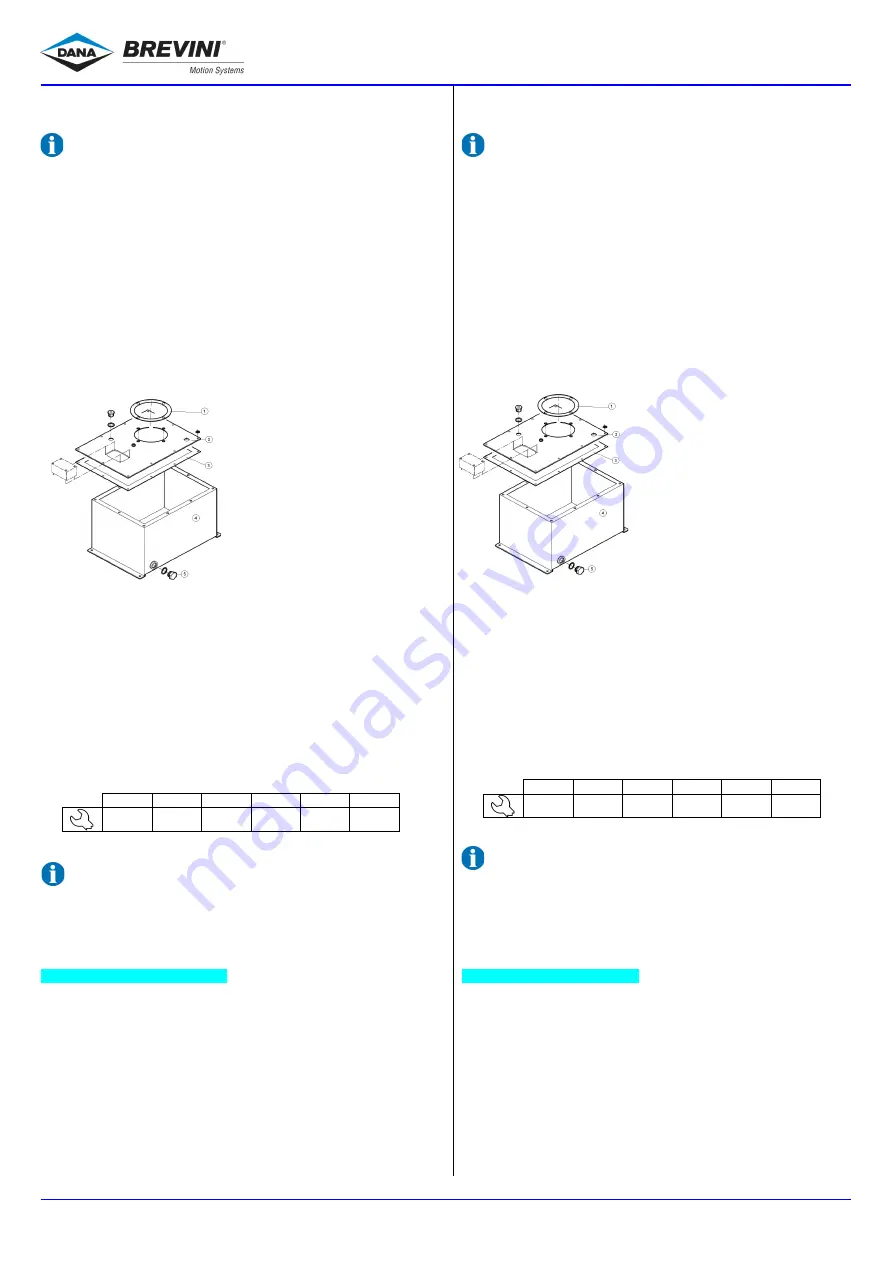
Istruzioni assemblaggio – Assembly instructions
Unità di Potenza / Power unit
Serie P1510 – ST – MH
DOC00034.doc Rev. D 8/8
Proprietà dell’azienda Dana Incorporated vietata qualsiasi riproduzione anche parziale senza l’autorizzazione della stessa. ISTRUZIONI ORIGINALI
Property of Dana Incorporated. Reproduction in whole or in part without express written consent is prohibited. ORIGINAL INSTRUCTIONS
idraulico; a tale proposito è importante mantenere la UP pulita per
individuare meglio detti trafilamenti: per la pulizia utilizzare esclusivamente
stracci puliti (escludere assolutamente solventi o detergenti).
Controllare il livello e lo stato del fluido idraulico, si consiglia di
eseguire il primo cambio del fluido idraulico dopo le prime 10 ore di
lavoro. Eseguire i successivi cambi ogni 3000 ore di lavoro ( o una
volta all’ anno).
Ad ogni cambio del fluido idraulico sostituire il filtro d’ aspirazione (ed
eventualmente altri filtri) ed eseguire la pulizia interna del serbatoio.
Prima di effettuare il cambio del fluido idraulico svuotare completamente
tutto l’ impianto. La frequenza del cambio del fluido idraulico sopra descritto
è riferito a temperature di esercizio comprese fra 30° ÷ 60°C (temperatura
del fluido idraulico).
Temperature più elevate possono determinare una drastica riduzione delle
caratteristiche di durata del fluido idraulico.
Sostituzione del filtro
Il filtro può essere sostituito con uno stesso filtro nuovo (vedere
“Identificazione del prodotto”), oppure può essere lavato e pulito, quindi
riutilizzato (vedere “Specifiche di sicurezza”)
Ogni serbatoio è dotato di un tappo di scarico
Smontaggio e rimontaggio dei serbatoi
Smontaggio
•
svitare il sistema di fissaggio tra coperchio e vasca del serbatoio
•
sfilare il gruppo motore - coperchio - pompa
Rimontaggio
•
controllare la pulizia del serbatoio
•
verificare il buono stato delle guarnizioni
•
introdurre e avvitare il gruppo motore - coperchio – pompa sulla vasca
Serraggi consigliati
Nel caso si rendano necessari eventuali smontaggi e rimontaggi di
componenti delle UP, nelle tabelle seguenti sono riportate le coppie di
serraggio consigliate
Coppie di serraggio
M8
M10
M12*
M12
M16*
G 1/2
10
25
18
45
30
30
*= solo per fissaggi delle lanterne sui coperchi dei serbatoi
I serraggi consigliati nella tabella sono considerati in riferimento al
materiale, al tipo di filettatura e ai più comuni componenti montabili. I
serraggi non sono validi per altri componenti in materiali diversi (plastiche) o
componenti che hanno diverse possibilità di avvitamento (come cacciaviti a
taglio, croce o altro) o se diversamente specificato. I serraggi non sono
validi per tappi e raccordi con filettature coniche.
DEMOLIZIONE E SMALTIMENTO
Nel caso in cui la UP debba essere demolita la si dovrà svuotare dall’ olio
contenuto che verrà smaltito secondo le prescrizioni di legge in vigore nel
Paese in cui avviene lo smaltimento. Lo stesso vale anche per le altre parti
della UP, considerando la tipologia dei materiali che la compongono, plastici
e ferrosi.
All' atto della Demolizione è necessario separare le parti in materiale
plastico dalla componentistica elettrica, che devono essere inviate a
raccolta differenziata nel rispetto delle Normative vigenti.
Per quanto concerne la massa metallica della UP, è sufficiente procedere
alla suddivisione tra le parti in acciaio e quelle in altri metalli o leghe, per un
corretto invio al riciclaggio per fusione. L' operazione di demolizione non
presenta rischi particolari, a condizione che sia effettuata da persone
sufficientemente preparate e dotate di mezzi adeguati (vedere capitolo
“Specifiche di sicurezza”).
seepage of hydraulic fluid. It is important to keep the HPU clean so that
leaks and seepage can be more easily seen. Only use clean cloths for
cleaning. Never use solvents or detergents.
Check the level and the condition of the hydraulic fluid. We
recommend changing the fluid the first time after the first 10 hours of
operation. Afterwards, change the fluid every 3000 hours of
operation (or once a year).
Whenever the hydraulic fluid is changed, replace the intake filter (and the
other filters, if installed) and clean the inside of the tank.
Before changing the hydraulic fluid, empty the entire system completely.
The fluid change interval described above applies at operating temperatures
of 30 °C to 60 °C (temperature of the hydraulic fluid).
Higher temperatures may seriously reduce the service life of the fluid.
Every tanks have drain plug
Replacing the filter
The filter can be replaced with a new filter of the same type (see the section,
“Product Identification"), or it can be washed, cleaned and reused (see the
section, "Safety Specifications").
Every tanks have drain plug
Removing and reinstalling the tanks
1. gasket for housing bell or flange
2. lid tank
3. tank gasket
4. tank
5. oil drai plug
Removal
•
Unscrew the fastening system between the lid and the tank
•
Pull out the motor-lid-pump group
Reinstallation
•
Make sure the tank is clean
•
Make sure the sealing gasket between tank and lid is in good condition
•
Introduce and tighten the motor-lid-pump group on the tank
Recommended tightening torque values
If components on the PU must be removed and reinstalled, tighten them to
the torque values listed on the following table:
Tightening torque
M8
M10
M12*
M12
M16*
G 1/2
10
25
18
45
30
30
*= only for fastening of housing bell on the tank lids
The recommended tightening torque values on the table are
differentiated according to material and type of thread on the flange
body and apply to the components that are most commonly removed. The
values do not apply to other components made of different materials
(plastic) or components that are tightened using other methods (such as
slot-head or Philips head screwdrivers, or other tools), or unless otherwise
specified. The torque values do not apply to plugs and fittings with tapered
threads.
DISMANTLING AND DISPOSAL
If the HPU must be dismantled, empty the fluid and dispose of it according
to the laws that apply in the country where it will be disposed of. The same
holds true for the other parts of the HPU; that is, dispose of them according
to the laws that apply to disposal of plastic and ferrous materials, as the
case may be.
When dismantling the unit, separate the plastic parts from the electrical
components, which must be disposed of separately in accordance with
current regulations.
The large metal sections of the HPU should be separated into parts made of
steel and parts made of other metals or alloys, so that they can be correctly
melted down for recycling. Dismantling is not a particularly risky operation,
as long as it is performed by properly trained personnel using adequate
tools (see the chapter, “Safety Specifications”).
1. Guarnizione per lanterna o flangia
2. Coperchio vasca serbatoio
3. Guarnizione serbatoio
4. Serbatoio
5. Tappo per scarico olio


























